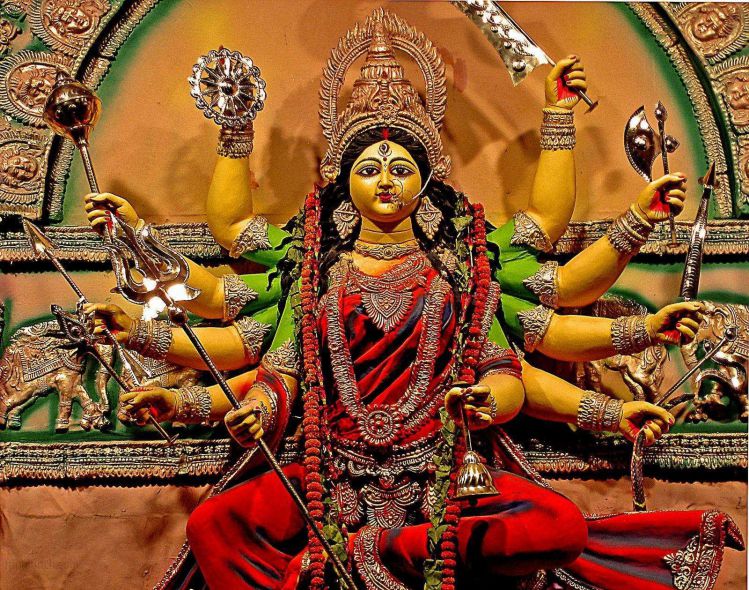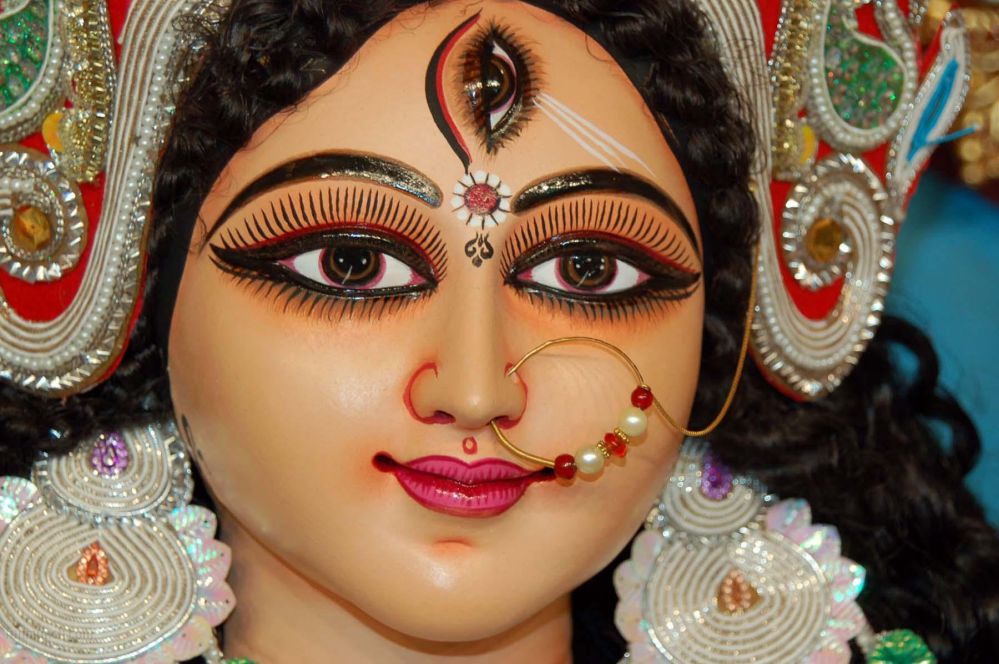No products in the cart.
Believed as the root cause of creation, sustenance and annihilation, Durga is the principal form of the Mother Goddess in Hinduism. The name ‘Durga’ in Sanskrit means ‘invincible’. The syllable ‘du’ is synonymous with the 4 devils namely poverty, sufferings, famine and evil habits. The ‘r’ refers to diseases and the ‘ga’ is the destroyer of sins, injustice, irreligion, cruelty and laziness.
Every year during the lunar month of Ashwin or Kartik (September-October), Hindus all over India and even in abroad observe ten days of ceremonies, rituals, fasts and feasts in honor of the Supreme Mother Goddess.
In the east, people go crazy over Durga Puja, from the sixth day till the tenth one of this annual festival. Especially in Bengal, this is the principal festival. This period falls in the fortnight corresponding to the festival and is called Devi Paksha (“Fortnight of the Goddess”). Devi Paksha is preceded by Mahalaya, the last day of the previous fortnight Pitri Paksha (“Fortnight of the Forefathers”), and is ended on Kojagori Lokkhi Puja (“Worship of Goddess Lakshmi on Kojagori Full Moon Night). Durga Puja marks the victory of Goddess Durga over the evil buffalo demon Mahishasura. Thus, this festival epitomises the victory of Good over Evil. Goddess Durga is worshipped as Durgotinashini, the destroyer of evil and the protector of her devotees. Durga Puja is celebrated with gaiety and devotion through public ceremonies of “Sarbojanin Puja” or “community worship” and commemorates the annual visit of the Goddess with her children to her parents’ home puja. Initially the Puja was organised by rich families since they had the money to organise the festival. During the late 19th and early 20th century, a burgeoning middle class, primarily in Calcutta, wished to observe the Puja. They created the community or Sarbojanin Pujas.
Devi’s Aagman and Gaman (Arrival and departure)
It is a popular belief that Devi arrives and departs in some form of transportation which predicts the lives of people for the coming year. There are various forms like Palki, Nouka (Boat), Ashwa (Horse), Gaj (Elephant),etc. each having its own significance. For example, the departure by horse signifies devastation as was the case in early day’s after any war. Coming by boat signifies natural gifts like a good harvest.
Durga Puja mood starts off with the Mahishasuramardini – a two-hour radio programme that has been popular with the community since the 1950s. ( Read More about – Devi Mahatmyam ) While earlier it used to be conducted live, later a recorded version began to be broadcasted. Bengalis traditionally wake up at 4 in the morning on Mahalaya day to listen to the enchanting voice of the late Birendra Krishna Bhadra and the late Pankaj Kumar Mullick on All India Radio as they recite hymns from the scriptures from the Devi Mahatmyam (Chandi Path). Thousands offer prayers on this day to their ancestors at the city’s river banks, a ritual called Tarpan.
The inauguration of the Goddess idol starts on Mahashasthi. The main puja is for three days – Mahasaptami, Maha ashtami, Mahanavami.
Huge decorative temporary structures called “pandals” are constructed to house the grand prayer services for the final 5 days along with the artistically depicted sculptures (murti) of Durga . Somewhere inside these complex edifices is a stage on which Durga reigns, standing on her lion mount, wielding ten weapons in her ten hands.
The ‘conch shell’ in Durga’s hand symbolizes the ‘Pranava’ or the mystic word ‘Om’, which indicates her holding on to God in the form of sound.

The ‘bow and arrow’ represent energy. By holding both the bow and arrow in one hand, “Mother Durga” indicates her control over both aspects of energy – potential and kinetic.
The ‘thunderbolt’ signifies firmness. One must be firm like thunderbolt in one’s convictions. Similar to thunderbolt that can break anything against which it strikes without being affected itself, the devotee should to undertake a challenge without losing his confidence.
The ‘lotus’ in Durga’s hand is not in full bloom which symbolizes the certainty of success but not finality.
The “Sudarshan-Chakra” which spins around the index finger of the Goddess signifies that the entire world is subservient to the will of Durga and is at her command. She uses this unfailing weapon to destroy evil and produce an environment conducive to the growth of righteousness.
The ‘sword’ that Durga holds in one of her hands symbolizes knowledge, which has the sharpness of a sword.
Durga’s ‘trident’ or ‘trishul’ is a symbol of three qualities – Satwa (inactivity), Rajas (activity) and Tamas (non-activity) – and that she is the remover of all the three types of miseries – physical, mental and spiritual. This being the religious center of the festivities, the crowds gather to offer flower worship or pushpanjali on the mornings here, of the sixth to ninth days of the waxing moon fortnight known as Devi Paksha (Devi = goddess; Paksha = period; Devi Paksha meaning the period of the goddess) which is followed by mass feeding, and cultural functions. Ritual drummers called the dhakis, carrying large leather-strung dhak, show off their skills during ritual dance worships called aarati.
2016 Durga Puja Dates
![]()
MahaShashthi
On this day Goddess Durga arrives to the mortal world from her heavenly abode, accompanied by her children. She is welcomed with much fanfare amidst the beats of dhak. Unveiling the face of the idol is the main ritual on this day. Kalaparambho, the ritual performed before the commencement of the puja precedes Bodhon, Amontron and Adibas.
MahaSaptami
Saptami is the first day of Durga puja. Kola Bow or Nabapatrika is given a pre-dawn bath. This is an ancient ritual of worshiping nine types of plants. They are together worshiped as a symbol of the goddess. The main Saptami Puja follows Kalparambho and Mahasnan.
MahaAshtami
The day began with a recital of Sanskrit hymns in community puja pandals as thousands of devotees offered anjali to the goddess. Kumari Puja or the worship of little girls as the mother goddess was a special part of the rituals observed in a number of traditional and household pujas. As the day wore on, it was time for the important Sandhi Puja, which marks the inter-linking of the Maha Ashtami and Maha Navami.
MahaNavami
This is the concluding day of Durga Puja. The main Navami puja begins after the end of Sandhi Puja. The Navami Bhog is offered to the goddess. This is later partaken as prasad by the devotees.
Dashami
After the three days of Puja comes Dashami, the last day and a tearful farewell is offered to the Goddess. Durga returns to her husband, Shiva, ritualised through her immersion into the waters called Bishorjon which is also known as Bhaashan and Pratima Niranjan. After the Bengali married women have participated in Sindur Khela, that is the smearing of the vermilion on Durga Puja’s last day Vijaya Dashami at a Durga puja pandal, the sculpture is taken for immersion in a procession amid loud chants of ‘Bolo Durga mai-ki jai’ (glory be to Mother Durga’) and ‘aashchhe bochhor abar hobe’ (‘it will happen again next year’) and drumbeats to the river or other nearby water body. It is cast in the waters symbolic of the departure of the deity to her home in the Himalayas. After this, in a tradition called Vijaya Dashami, families visit each other and sweetmeats are offered to visitors (Dashami is literally “tenth day” and Vijay is “victory”).
Durga Puja Mantra
Mantras, the integral part of Durga puja are accompanied by the rhythmic beatings of the dhak, smell of the incense sticks, “ululu”, “dhoono”, and flowers. These create the atmosphere of Durga puja and are chanted in the morning as well as in the evening for the consecutive five days, Shashthi, Maha Saptami, Maha Ashtami, Maha Navami and Vijaya Dashami. Hence, chanting of mantras in Sanskrit is an essential part of the Durga Puja festival. In Hinduism whenever the priest worships Goddess Durga, he has to utter a mantra which gives an account of Goddess Durga together with Ashtanayika (her eight eternal playmates). The priest then deeply concentrates his mind upon Goddess Durga together with Ashtanayika (her eight eternal playmates or companions).
A part of Durga Puja’s Pushpanjali Mantra chanted during the conduction of Maha Pushapanjali on Ashtami and Navami is given below :
“Om Jayanti, Mangala, Kali, Bhadrakali, Kapalini. Durga, Shiba, Kshama, Dhatri, Swaha, Swadha Namahstu Te.
Esha Sachandana Gandha Pushpa Bilwa Patranjali, Om Hrring Durgaoi Namah”
Durga Slokas (which is also known as Devi Mantra) praises Durga as symbol of all divine forces. According to the sloka chanted during Pushapanjali and aarati, Durga is omnipresent as the embodiment of power, intelligence, peace, wealth, morality etc.
A part of Durga Sloka is as follows:
“Ya Devi sarva bhuteshu Matri rupena samsthita
Ya Devi sarva bhuteshu Shakti rupena samsthita
Ya Devi sarva bhutesu Shanti rupena samsthita
Namestasyai Namestasyai Namestasyai Namoh Namah”
Meaning : ‘The goddess who is omnipresent as the personification of universal mother
The goddess who is omnipresent as the embodiment of power
The goddess who is omnipresent as the symbol of peace
I bow to her, I bow to her, I bow to her.’
The puja rituals are essentially long and very detailed and complicated.
Hindus especially in West Bengal celebrate Durga puja with new clothes and other gifts, which are worn on the evenings when the family goes out to see the ‘pandals’. Although it is a Hindu festival, religion takes a back seat on these five days. Durga Puja in Bengal especially is a carnival, where people from all backgrounds, regardless of their religious beliefs, participate and enjoy themselves to the hilt.







